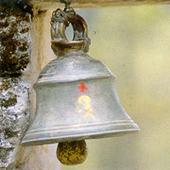 |
|
Bells
are considered sacred in Indian culture. Various designs
are caste in different metals including a mixture of five
metals called panchloha. Bells of great antiquity are
found in India's ancient temples and churches and are
rung each morning and evening to celebrate the link between
man and divinity.
|
|
Puja or worship, a series of rituals
in household altars or consecrated temples, can be ornate or simple.
When it is simple adoration of god, it consists of people gathering
together to sing devotional songs, to the accompaniment of musical
instruments, to hear philosophical or Puranic discourses and to share
prasad or holy food at the end of the session. A Kirtan is a mix of
singing, story-telling and offering worship to a deity with flowers
and various foods.
But ornate worship is much more ritualistic with several upacharas
or services being performed in adoration of the deity. Various traditions
temples decide the number of upacharas to be performed but almost
everywhere in India, certain basic ones are performed to constitute
worship. They are Prabodha, or awakening of the deity; Snana, a ceremonial
bathing of the deity; Avahana, invitation to the deity; Archaka, or
the welcome; Pradakshina or the circumambulation; Naivedya, offering
of food; Aarti, the lamp adoration; Prarthana, or the prayers and
Visarjana or bidding farewell.
 |
|
Among
the food offered to god in worship is a variety of dry
fruits, sugar and puffed rice. Every food is equally pleasing
to god as everything offered to divinity originates in
his creative power. All food is eventually called prasad
or a benediction.
|
|
In these basic upacharas, the deity is
awakened with music and hymns of praise. The Nirmalya or the flowers
and leaves used earlier, are discarded and the sanctum is cleaned.
A ceremonial bath is given to a small representative idol using fragrant
materials like saffron or sandalwood. Then the deity is dressed in
fresh robes and decorated with ornaments. Next, the deity is invited
by ringing bells and blowing a conch.
Thereafter the deity is welcomed by presenting garlands, offering
a seat and the giving of water for washing his feet and for ritualistic
sipping.
This is followed by circumambulation or walking around the deity with
folded hands and then by offering food and mildly perfumed water,
all amidst the aroma of flowers and incense. The food thus offered
is afterwards distributed to devotees as prasad and is believed to
have great power of benediction. Aarti, and the accompanying prarthana
form a collective request to the deity for health, wealth and wisdom.
The worship rituals end when the deity is bid farewell by chanting
of mantras.

